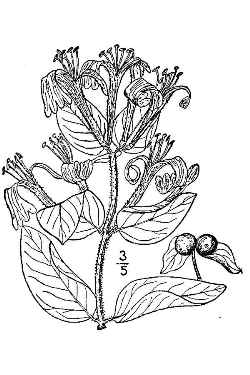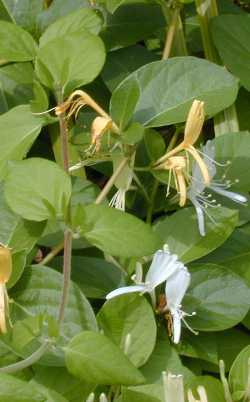Japanese Honeysuckle, Hall's Honeysuckle
Scientific Name: Lonicera japonica Thunb. ex Murray
Family: Caprifoliaceae
Sunset®: 2-24
USDA: 7-10
Frost Tolerance: Hardy in Phoenix
Sun Exposure: Full sun to light shade
Origin: Japan
Growth Habits: Evergreen vine to 15 feet
Flowers: White flowers
Watering Needs: Moderate water
Propagation: Stem cuttings, layering

Lonicera japonica, Britton, N.L., and A. Brown. 1913. Illustrated flora of the northern states and Canada. Vol. 3: 280. Courtesy of Kentucky Native Plant Society.
Hall's honeysuckle is the most common of the Japanese honeysuckles in the Phoenix area. This honeysuckle can be used as an effective ground cover, but it may become invasive.
Blooming Habits:
The fragrant flowers start white and become yellow at maturity to attract bees (see picture). In Phoenix weather, the flowers are not extremely fragrant, but when as they come in large quantities, their scent can be very noticeable.
Culture:
Left alone, it will become bushier and bushier, with the inside of the bush containing dried stems becoming a fire hazard. Trim severely in the fall to prevent the buildup.
Propagation:
Layering is very simple, just grab a bunch of new vines, and stuff them in a pot, so that on one side of the pot you have the part of the vine still attached to the mother plant and on the other side of the pot, you have the other extremity of the vine. Fill up the pot with dirt. Water occasionally for a couple of months, and your honeysuckes should be ready to be cut away from the mother plant.
Seeds need stratification for 3 months at 40°F (4°C). If they don't germinate, dig them out, and stratify them again.
Desert-Tropicals is dedicated to provide gardening advice, gardening ideas, and information about flower of all kind for landscape and collections.We try to check carefully the identification of the plants on the illustrations as well as the other information from the page, but occasionally errors do occur. if you notice anything that needs to be changed please contact us.Thanks.
© 1998-2020 Philippe Faucon, All Rights Reserved.
